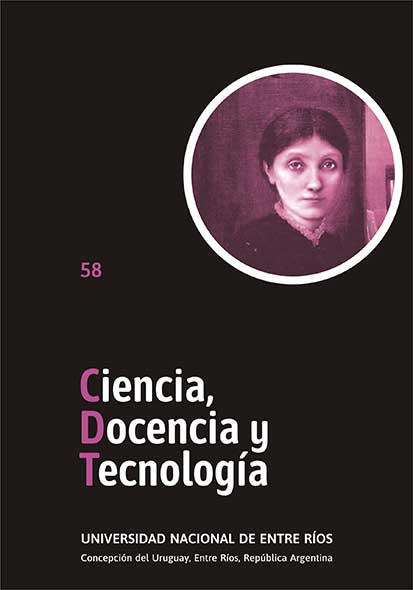Creencias de profesores en formación sobre el uso de Pizarras interactivas de bajo costo
DOI:
https://doi.org/10.33255/3058/479Palabras clave:
Informática educativa, modelo educativo, enseñanza asistida por ordenador, brecha digital, proyecto de investigación educativaResumen
Esta investigación utiliza el instrumento cualitativo de la Teoría del Comportamiento Planificado (TPB) para obtener las creencias hacia la implementación pedagógica de un dispositivo de interfaz humana similar a las pizarras digitales interactivas. El instrumento se aplicó a estudiantes de pedagogía que participaron de un curso sobre el uso técnico y pedagógico de pizarras digitales. El conjunto de respuestas se sometió a un análisis de contenido generando categorías de creencias en el ámbito de los factores personales, contextuales y de control, que estarían mediando en su implementación. Posteriormente, se utilizaron criterios cuantitativos para seleccionar aquellas creencias que formarán parte del instrumento metodológico principal de TPB. En total dieciséis creencias fueron seleccionadas según un criterio que contempla tanto la cobertura de sujetos como de cantidad de creencias y que finalmente conforman el conjunto modal. Estas creencias son utilizadas para diseñar una estructura de capacitación dirigida a docentes en formación.Descargas
Citas
Ajzen, I., 2005. Attitudes, personality and behavior, 2 edition. ed. Open University Press, Maidenhead.
Ajzen, I., 1991. The theory of planned behavior. Organizational Behavior and Human Decision Processes, Theories of Cognitive Self-Regulation 50, 179–211. https://doi.org/10.1016/0749-5978(91)90020-T
Ajzen, I., 1985. From intentions to actions: A Theory of Planned Behavior, in: Kuhl, J., Beckmann, J. (Eds.), Action Control, SSSP Springer Series in Social Psychology. Springer, Berlin, Heidelberg, pp. 11–39. https://doi.org/10.1007/978-3-642-69746-3_2
Ajzen, I., Fishbein, M., 2000. Attitudes and the Attitude-Behavior Relation: Reasoned and Automatic Processes. European Review of Social Psychology 11, 1–33. https://doi.org/10.1080/14792779943000116
Ajzen, I., Fishbein, M., Heilbroner, R.L., 1980. Understanding attitudes and predicting social behavior, Edición: Revised. ed. Pearson Education., Englewood Cliffs, N.J.
Albirini, A., 2006. Teachers’ attitudes toward information and communication technologies: the case of Syrian EFL teachers. Computers & Education 47, 373–398. https://doi.org/10.1016/j.compedu.2004.10.013
Aldunate, R., Nussbaum, M., 2013. Teacher adoption of technology. Computers in Human Behavior 29, 519–524. https://doi.org/10.1016/j.chb.2012.10.017
Anderson, T., Poellhuber, B., McKerlich, R., 2010. Self paced learners meet social software: An exploration of eearners’ attitudes, expectations and experience. Online Journal of Distance Learning Administration 13.
Beauchamp, G., Kennewell, S., 2010. Interactivity in the classroom and its impact on learning. Computers & Education, Learning in Digital Worlds: Selected Contributions from the CAL 09 Conference 54, 759–766. https://doi.org/10.1016/j.compedu.2009.09.033
Cassany, D., Carles, S.L., 2017. La digitalización del aula de ciencias: creencias y prácticas. Digital Education Review 93–115.
Chen, T.-L., Chen, T.-J., 2006. Examination of attitudes towards teaching online courses based on theory of reasoned action of university faculty in Taiwan. British Journal of Educational Technology 37, 683–693. https://doi.org/10.1111/j.1467-8535.2006.00590.x
Ekizoglu, N., Ozcinar, Z., 2011. A study of developing an anxiety scale towards the internet. Procedia - Social and Behavioral Sciences, 3rd World Conference on Educational Sciences - 2011 15, 3902–3911. https://doi.org/10.1016/j.sbspro.2011.04.392
Fishbein, M., Ajzen, I., 2011. Predicting and changing behavior: The reasoned action approach, Taylor & Francis. ed. Psychology Press, New York.
Fishbein, M., Ajzen, I., 1975. Belief, attitude, intention, and behavior: an introduction to theory and research, Addison-Wesley series in social psychology. Addison-Wesley Pub. Co., MA.
Francis, J.J., University of Newcastle upon Tyne, Centre for Health Services Research, 2004. Constructing questionnaires based on the theory of planned behaviour: a manual for health services researchers. Centre for Health Services Research, University of Newcastle, Newcastle upon Tyne.
French, D.P., Sutton, S., Hennings, S.J., Mitchell, J., Wareham, N.J., Griffin, S., Hardeman, W., Kinmonth, A.L., 2005. The importance of affective beliefs and attitudes in the Theory of Planned Behavior: Predicting intention to increase physical activity. Journal of Applied Social Psychology 35, 1824–1848. https://doi.org/10.1111/j.1559-1816.2005.tb02197.x
García, Y., Reyes-González, D., Rojas, P., 2012. Pizarras digitales e interactividad en el aula: estilos de uso y principales factores que afectan su adopción. Educación y Tecnología 0, 69–81.
Haney, J.J., Czerniak, C.M., Lumpe, A.T., 1996. Teacher beliefs and intentions regarding the implementation of science education reform strands. Journal of Research in Science Teaching 33, 971–993. https://doi.org/10.1002/(SICI)1098-2736(199611)33:9<971::AID-TEA2>3.0.CO;2-S
Hennessy, S., Ruthven, K., Brindley, S., 2005. Teacher perspectives on integrating ICT into subject teaching: commitment, constraints, caution, and change. Journal of Curriculum Studies 37, 155–192. https://doi.org/10.1080/0022027032000276961
Herath, C.S., 2010. Eliciting salient beliefs are critical to predict behavioural change in theory of planned behaviour. E-psychologie (E-psychology) 4, 24–36.
Holzinger, A., Softic, S., Stickel, C., Ebner, M., Debevc, M., 2009. Intuitive e-teaching by using combined HCI devices: Experiences with wiimote applications, in: Universal Access in Human-Computer Interaction. Applications and Services, Lecture Notes in Computer Science. Presented at the International Conference on Universal Access in Human-Computer Interaction, Springer, Berlin, Heidelberg, pp. 44–52. https://doi.org/10.1007/978-3-642-02713-0_5
Kitchen, S., Mackenzie, H., Butt, S., Finch, S., 2006. Evaluation of curriculum online report of the third survey of schools. Becta ICT Research.
Lee, J.C., 2008. Hacking the Nintendo Wii Remote. IEEE Pervasive Computing 7, 39–45. https://doi.org/10.1109/MPRV.2008.53
Lee, J.C., Hudson, S.E., Summet, J.W., Dietz, P.H., 2005. Moveable interactive projected displays using projector based tracking, in: Proceedings of the 18th Annual ACM Symposium on User Interface Software and Technology, UIST ’05. ACM, New York, NY, USA, pp. 63–72. https://doi.org/10.1145/1095034.1095045
Lim, C.P., Chan, B.C., 2007. microLESSONS in teacher education: Examining pre-service teachers’ pedagogical beliefs. Computers & Education 48, 474–494. https://doi.org/10.1016/j.compedu.2005.03.005
López, O.S., 2010. The Digital Learning Classroom: Improving English Language Learners’ academic success in mathematics and reading using interactive whiteboard technology. Computers & Education 54, 901–915. https://doi.org/10.1016/j.compedu.2009.09.019
Mata, L., Lazar, G., Lazar, I., 2016. Effects of study levels on students’ attitudes towards interactive whiteboards in higher education. Computers in Human Behavior 54, 278–289. https://doi.org/10.1016/j.chb.2015.07.044
Niederhauser, D.S., Stoddart, T., 2001. Teachers’ instructional perspectives and use of educational software. Teaching and Teacher Education 17, 15–31. https://doi.org/10.1016/S0742-051X(00)00036-6
Perea, C.D., 2011. Creación de objetos de enseñanza y aprendizaje mediante el uso didáctico de la pizarra digital interactiva (PDI). Education in the Knowledge Society (EKS) 12, 116–143.
Reyes-González, D., Martín García, A.V., 2008. Creencias de los docentes de formación inicial sobre las tecnologías infocomunicacionales. Una aproximación desde la Teoría del Comportamiento Planificado, in: EUniverSALearning 08: II Congreso Internacional de Tecnología, Formación y Comunicación. Salamanca, España.
Reyes-González, D., Martín-García, A.V., 2016. Creencias de docentes en formación que afectan el uso de recursos tecnológicos. Ciencia, Docencia y Tecnología 27, 293–314.
Reyes-González, D., Rojas, P., García, Y., 2011. Diseño y desarrollo de Dispositivo de Interfaz Humana (DIH) de bajo costo y como alternativa a las Pizarras Digitales. Presented at the 1o Jornadas de Investigación DIUMCE, UMCE, Santiago de Chile.
Rodríguez, P., Nussbaum, M., Dombrovskaia, L., 2012. Evolutionary development: a model for the design, implementation, and evaluation of ICT for education programmes. Journal of Computer Assisted Learning 28, 81–98. https://doi.org/10.1111/j.1365-2729.2011.00419.x
Rojas, P., Reyes-González, D., García, Y., 2011. Interactividad y pizarras digitales en espacios formativos, in: Garzón Clemente, R., Román Julián, R., Solís Muñiz, A., González Scarpulli, D. (Eds.), Tecnologías de La Información y La Comunicación En La Educación: Aportes Desde Una Perspectiva Iberoamericana. Chiapas, México.
Scrimshaw, P., 2004. Enabling teachers to make successful use of ICT. Becta ICT Research.
Sugar, W., Crawley, F., Fine, B., 2005. Critiquing Theory of Planned Behaviour as a method to assess teachers’ technology integration attitudes. British Journal of Educational Technology 36, 331–334. https://doi.org/10.1111/j.1467-8535.2005.00462.x
Sugar, W., Crawley, F., Fine, B., 2004. Examining teachers’ decisions to adopt new technology. Educational Technology & Society 7, 201–2013.
Sutton, S., French, D.P., Hennings, S.J., Mitchell, J., Wareham, N.J., Griffin, S., Hardeman, W., Kinmonth, A.L., 2003. Eliciting salient beliefs in research on the theory of planned behaviour: The effect of question wording. Curr Psychol 22, 234–251. https://doi.org/10.1007/s12144-003-1019-1
Thatcher, J.B., Perrewé, P.L., 2002. An empirical examination of individual traits as antecedents to computer anxiety and computer self-efficacy. MIS Quarterly 26, 381–396. https://doi.org/10.2307/4132314
Wang, Z., Louey, J., 2008. Economical Solution for an Easy to Use Interactive Whiteboard, in: 2008 Japan-China Joint Workshop on Frontier of Computer Science and Technology. Presented at the 2008 Japan-China Joint Workshop on Frontier of Computer Science and Technology, pp. 197–203. https://doi.org/10.1109/FCST.2008.22
Warwick, P., Mercer, N., Kershner, R., Staarman, J.K., 2010. In the mind and in the technology: The vicarious presence of the teacher in pupil’s learning of science in collaborative group activity at the interactive whiteboard. Computers & Education 55, 350–362. https://doi.org/10.1016/j.compedu.2010.02.001
Way, J., Lilley, E., Johnco, S., Ruster, C., Mauric, L., Ochs, L., 2009. Interactive whiteboards and pedagogy in primary classrooms, in: Australian Association for Research in Education - Annual Conference. Canberra.
Workman, M., 2005. Social cognitive effects on information and technology Use. Journal of Information Science and Technology.
Publicado
Cómo citar
Número
Sección
Licencia
Los autores conservan los derechos de autor y garantizan a la revista el derecho de ser la primera publicación del trabajo, al igual que licenciarlo bajo una Creative Commons Attribution License que permite a otros compartir el trabajo con un reconocimiento de la autoría del trabajo y la publicación inicial en esta revista. Todo el contenido es publicado bajo licencia internacional Creative Commons 4.0: Atribución-No Comercial-Compartir Igual.






